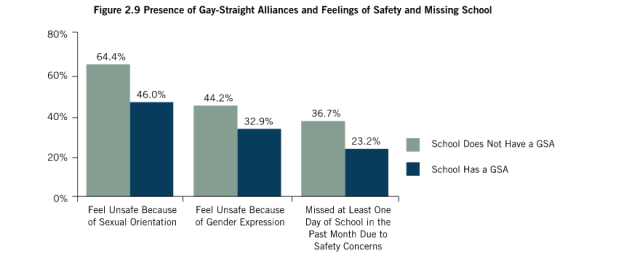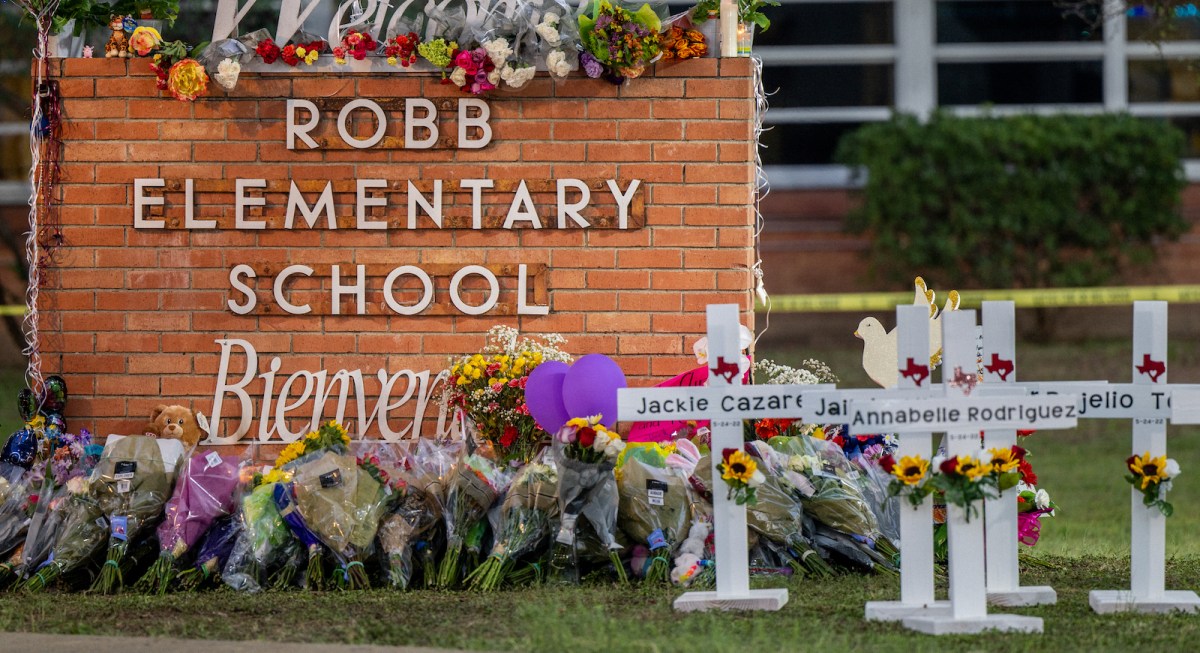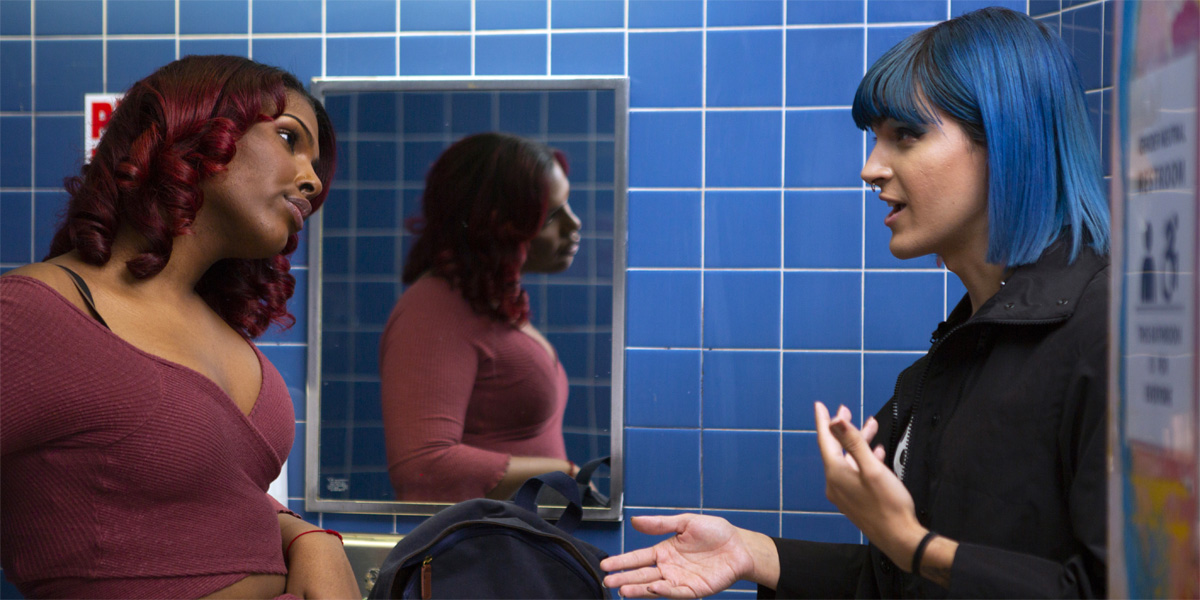feature image via shutterstock
For many LGBT youth, their K-12 educators and school faculty are the adults they see most besides their parents. Depending on their home situation, they may actually have more contact or be closer with their teachers than parents or guardians. School has the potential to be a transformative place for LGBT youth where they learn about the world and themselves, so they can go into the world as empowered, thoughtful adults. Unfortunately, it also has the potential to be a scary and unsafe place where LGBT youth’s worst fears about their identities are confirmed by students and staff alike. Individual educators committed to supporting LGBT youth can be a big part of the difference between the two.

It’s not necessarily easy to be an ally to LGBT youth in schools — lately it feels like every other week there’s a new story about an educator being fired for their sexual orientation or even being pressured to resign for reading an LGBT-friendly book in class. An individual educator may also find that their hands are tied frustratingly often — they may be working to make their own classroom safe and affirming, but feel powerless in the face of administrative attitudes or schoolwide policies that make life miserable for LGBT youth outside of their classroom. While no one educator can change the world, they can make a difference. Many of us have GLSEN’s Safe Space stickers in our classrooms, which is a good start — students have reported in GLSEN’s National School Climate Survey that seeing a Safe Space sticker makes them more likely to feel comfortable talking to the adult in question about LGBT issues. But it’s on us as educators to make sure that those stickers mean something — that they symbolize more than just a supportive staff member, but truly a safe space. While not all of these ideas will be possible for every educator, here are ten ideas for how to make that safe space a reality for LGBT youth.
1. Plan LGBT-inclusive curriculum that includes positive representations of LGBT people
Curriculum that acknowledges the existence of LGBT people and, even better, shows them in a positive light, has a major impact on the wellness of LGBT students. It has the dual benefit of letting LGBT students know that they’re not shameful or alone in the world as well as familiarizing other students with LGBT narratives, which can make the overall school environment less likely to be hostile and even encourage straight, cis students to speak up if they see or hear something harmful. GLSEN’s most recent National School Climate Survey found that “students in schools with an inclusive curriculum were half as likely to have experienced higher levels of victimization, compared to students in schools without an inclusive curriculum (12.6% vs. 31.0% for victimization based on sexual orientation; 14.1% vs. 30.5% for victimization based on gender expression).” Students also indicated they felt safer, and that they were less likely to hear negative remarks on the basis of sexual orientation or gender expression.

An inclusive curriculum can be easier said than done. There might be constraints from the administration or concerns about backlash from parents, or it might just be logistically challenging — how do you make teaching precalculus LGBT-inclusive? Even small gestures, however, can feel enormous to an individual student: a single short story assigned throughout the semester with a same-sex family in it, a word problem in which a same-sex couple on a date has to figure out their tip, making sure to also mention Tam O’Shaughnessy when teaching about Sally Ride, a casual mention of any of the same-sex relationships of the suffragette movement. If you have an in-class library or set of resources, you can try to make sure that there are a few books or movies on LGBT topics for people to look through, even if you never assign them. Many of us made it to adulthood without knowing many of our historical role models belonged to our community; maybe the next generation won’t have to.
2. Advise a GSA, or help start one in your school
Gay-Straight Alliances (GSAs) certainly can’t fix every problem that LGBT students face, but they can sure help. A GSA can be a space where a student can get a break from feeling like an “other,” even if only for a brief time, and have access to at least one staff member that they can feel reasonably confident is supportive of them. In most schools, students can’t start a GSA without an adult faculty member to serve as its advisor; if there are students who have been wishing for a GSA in your school, you can show up for them by being the advisor for it, and helping them navigate any administrative hoops they need to jump through to make it happen. It’s illegal for a school to prohibit their students from starting a GSA; students deserve to have one. GLSEN has resources for GSA advisors if you’re not sure where to start.

If you do become involved with a GSA (or already are), think about how you can work to make that space even more enriching and affirming for them. With the permission of the students, and depending on what they want their GSA to be, could the group organize a series of discussions or readings on consent or LGBT mental health? Could the GSA start a book club or decide on a series of documentaries they want to watch? Is there programming or activism they’d like to do in the school at large, and if so, how can you support them in doing that? Invite the students to articulate their needs and wants and wishes, and figure out how you can best help realize them.
3. Actively intervene when you hear anti-LGBT remarks, both with students and staff
Whether or not school staff frequently and decisively intervene when homophobic or transphobic remarks are made is found over and over again to be a major factor in students’ wellbeing in school. When faculty intervene in situations that make LGBT students feel unsafe, they’re sending a message to those students that their happiness and safety is valued and valuable, and that their wellness and learning is a priority. That message makes a big difference — according the National School Climate Survey students who report that faculty are likely to intervene in homophobic or transphobic language are less likely to miss school because they feel safer showing up to the building, which increases their options for academic success and higher education if they wish. The main reason given by students who don’t report harassment or assault — and that’s more than half of students who have experienced it — is that they don’t believe anything will be done about it. It’s on you to give them reason to think otherwise.

Intervening in these situations every single time can be tricky and draining — it can be hard to get a class back on track after an interruption, and it’s difficult to be eloquent on the spot about why that behavior is inappropriate, especially if you’re worried about betraying a set of personal beliefs or politics. Try taking some time when you’re not at school and have a clear head to prepare some responses to situations you imagine you might encounter — even practice them so that when something does come up in the halls or in the middle of a lesson, you don’t need to think about it and don’t get flustered.

It may be necessary to intervene not just with students, but with fellow faculty members — over half of students participating in GLSENs National School Climate Survey had heard homophobic remarks from school faculty at least once in the past year, with about 18% of students reporting that they hear these comments “sometimes,” “often,” or “frequently.” Obviously confronting open bigotry from adults whom they’re supposed to be able to trust and rely on doesn’t make students feel safe or engaged in their educational environment. Make a plan for what you think would be the most effective way to handle a school staff member making offensive remarks — talk to them one-on-one? gather a group of other faculty to approach them? talk to an administrator? — so that if the situation presents itself, you already know what to do.
4. Look into your district’s anti-bullying/anti-harassment policy, and push for a comprehensive one if you don’t have one already
Intervening in harmful situations for LGBT students is already challenging as an educator, and even if you manage to do so perfectly, it’s likely students are only in your space for a small portion of their day. Having a comprehensive anti-harassment policy in place at your school — one that explicitly says that harassment or bullying on the basis of sexual orientation and gender expression/identity isn’t tolerated — has been shown to be linked with higher rates of both staff and student intervention in anti-LGBT incidents. It can make it easier for you to intervene in those moments as well — you can give the school’s harassment policy as a simple reason why the harmful behavior needs to stop, instead of having to make a case yourself in what may be a high-pressure situation. Many schools already have some sort of anti-bullying policy, but few of them have policies that students know cover both sexual orientation and gender identity — only 10.1% of schools in 2013 had a comprehensive policy that students were aware of, and 17.9% of students surveyed weren’t aware of having any anti-bullying policy at all. The data is clear that the more comprehensive the school’s anti-harassment policy, the less likely students are to hear anti-LGBT statements in their school, and the less likely they are to experience victimization. The research also shows that students find staff intervention in homophobic remarks more frequent and more effective when the school’s policy is comprehensive, and that they’re more likely to report harassment they experience.

No one educator can singlehandedly change a schoolwide policy, but you do have the power to look into the current situation and figure out what would need to happen to make change. What is your school’s current policy? Do students know about it? If not, what would be an effective way to make them aware? What steps would need to be taken to make changes to your school’s harassment policy, and how could you take action on them? You can’t do it all yourself, but you can do your part.
5. Remember that you may not know who in your class is LGBT
For LGBT educators, there may be a tendency to be especially aware of those LGBT students who remind us of ourselves, or who fit our own ideas of what our community looks like. There’s definitely something hugely significant in letting a student who seems to be struggling with the same things you were do the book report on Annie on My Mind that you were never allowed to, but it’s important to also be aware of the LGBT students who need our support even though we may not know about them. We have no way of knowing how anyone in our classrooms truly identifies, or may come to identify once they have the language and self-awareness to do so. The football quarterback dating the cheerleading captain, the young mom who had an unplanned pregnancy, and the troublemaker who picks fights in the hall could all be LGBT students who need specific support. It’s important that we work to make our classrooms, our lessons and our educational communities safe for and invested in LGBT youth even when we don’t think there are any in the room, and leave our assumptions about who LGBT youth are and what they look like at the door.
6. Don’t decide for yourself what kind of support LGBT youth need
Especially if we’re LGBT adults, there may be an urge to enact what we think of when we think of LGBT youth, or what we wish we had when we were younger — rush to counsel them about coming out, or assume that they want to talk about a same-sex crush. There’s a dangerous seduction in allyship to think of ourselves as heroes, and to be drawn towards the most noble allyship we imagine, whether that’s crusading for a student’s right to wear gender-nonconforming clothing to prom or to magically fix all their internalized homophobia through the strength of your support. LGBT youth may very well need all those things, but we need to commit to letting them determine how you can help them for themselves. They may be more concerned about a conflict with friends than with coming out to their parents or more invested in starting a manga club than starting a GSA, and that doesn’t make your support for them any less necessary.
7. Be mindful of interactions with parents and guardians of LGBT students
For some LGBT youth, school is a safer and more welcoming space than their home. They may be more open about their sexual orientation or gender identity at school, or they may be involved in LGBT projects or student groups without their parents’ knowledge. If a parent-teacher conference or an academic or behavioral issue means you’re going to be in contact with family or guardians, be mindful of sharing any information, potentially including things like a chosen name or correct pronouns, that may out a student in what could be an unsafe home situation. If your relationship with an LGBT student is close, be willing to ask them about their relationship with their family and what information they feel comfortable having shared.
8. Be aware of signs of physical assault and/or mental health warning signs
Physical harassment and assault in school is a reality for an alarming number of LGBT youth, even on top of the possibility of abuse in the home. More than half of students say that they don’t report these incidents when they happen, which means LGBT students in your schools may well be experiencing assault without you knowing. Keep an eye out for students with injuries, who seem to be avoiding spaces where they’re left alone with other students like locker rooms, and be willing to ask them gently if anyone is hurting them. If they confirm that someone is, understand that a student may not want to report it to the administration for valid reasons — they may not want their parents to find out, or they may reasonably fear that they’ll be disciplined in addition to the person who assaulted them. It may be required in your school or state for you to report it if a student has been physically harmed by another student; it’s important to be aware of the statutes in that case. If a student doesn’t wish to report, talk with them about other options to help keep them safe, like walking with them in the halls or letting them eat somewhere besides the cafeteria.
LGBT youth are a population that may experience mental health issues like depression or even suicide. Again, it would be ideal if students all reported these issues as soon as they came up, but that’s not likely. If a student seems to have decreased interest in activities they used to be enthusiastic about, has a sudden dropoff in academic performance even though you don’t think the material is too challenging for them, or seems to have a noticeable change in personality or behavior, it’s worth talking to them one on one to see what’s going on. The Trevor Project has resources on the warning signs and risk factors of suicide, and what to say and do if you do find that a student is in crisis. It’s important to make sure you have a plan for how to help if a student does report serious mental health issues or is thinking about harming themselves or others; familiarize yourself with what mental health resources youth in your school can access. Again, it may be required in your school and/or state to report it to parents or administration if a student is struggling with mental health, self-harm or suicidality, but also keep in mind that they may wish to avoid alerting parents or authority figures for fear of further harm or fear of outing themselves.
9. Look into your school policy and state laws around gendered bathrooms and clothing
Almost two-thirds of trans students in the National School Climate Survey reported avoiding bathrooms because of feeling unsafe or uncomfortable in them, and 59.2% had been forced to use the bathroom or locker room of their assigned sex at birth. While trans students report facing many indignities and instances of discrimination, from being forced to wear the clothing of their assigned gender to not being allowed to use their chosen name, not using the bathroom and being forced to use the bathroom of their assigned gender open trans students up to urgent health and safety issues. The 2012 report “Respecting the Rights of Transgender Youth in the School System” explains that “trans teens may be subject to ridicule, abuse or assault, physical or sexual, in public lavatories.” An ideal situation would be a school nondiscrimination policy specifically stating that students should be free to use the restrooms and wear the clothing of the gender they identify with, and an anti-harassment policy that attempts to protect students from harassment in those situations. When it comes to restrooms, some schools use the stopgap measure of designating a “unisex” bathroom and allowing trans students to use that, or giving them access to staff bathrooms. Many feel that a unisex bathroom solution still marks transgender youth as “other” and reinforces for both the trans student and cis students the belief that trans students are different from normal kids or that their gender is weird.
Again, this is the kind of policy issue that’s difficult for one educator to change on their own, but you can research what your school’s current policy is and what the laws are in your state — if a trans or gender nonconforming student wants to push for their rights, does the law back them? What options are there when it comes to addressing school policy? Could you bring up changes with an administrator? Most importantly, what would make the trans students in your school feel safest? If you’re close with a trans student or students and they feel comfortable talking about it, ask what their ideal would be and if they’d like support in pursuing it.
10. Coming out if possible
Coming out in the workplace is a big risk for LGBT adults across many industries, but for teachers it carries a special risk. Many people are still, unfortunately, uncomfortable with LGBT people working with their children, and especially if you work at a private or parochial school, your school may agree with them and fire you without any legal repercussions. There may be legitimate concerns about how your students will view you afterwards, and whether they’ll continue to respect you as an educator and authority figure. Certainly, coming out if you’re worried about your job security isn’t necessary and may be even unhelpful; if you’re replaced by someone who isn’t supportive of LGBT youth, then obviously the youth in your school will be worse off.
That said, this is one really major way that you can show LGBT youth that they’re not alone, and that there is a future for them. Many LGBT youth may not know an LGBT adult in their personal lives who can serve as proof that LGBT people can grow up to lead fulfilling lives with loving, safe relationships; some LGBT youth may not know any other LGBT people at all. Speaking personally, I still remember every out teacher I ever had, especially in high school. I was never out to any of them, and they likely thought of me as straight, but seeing them live openly made a huge impact on me. While I still remember my high school English teacher coming out to the entire class as bisexual, a big announcement may not be necessary; it can also be hugely meaningful to come out to an individual student if they share with you that they’re dealing with issues of sexual orientation or gender identity.







